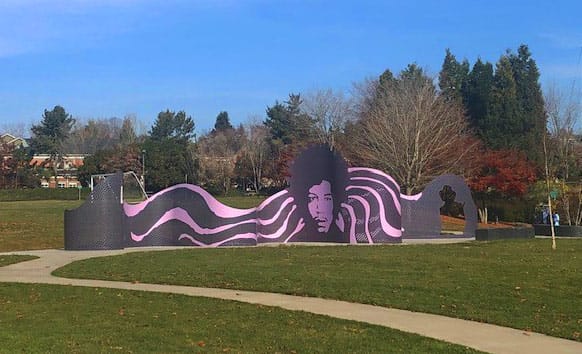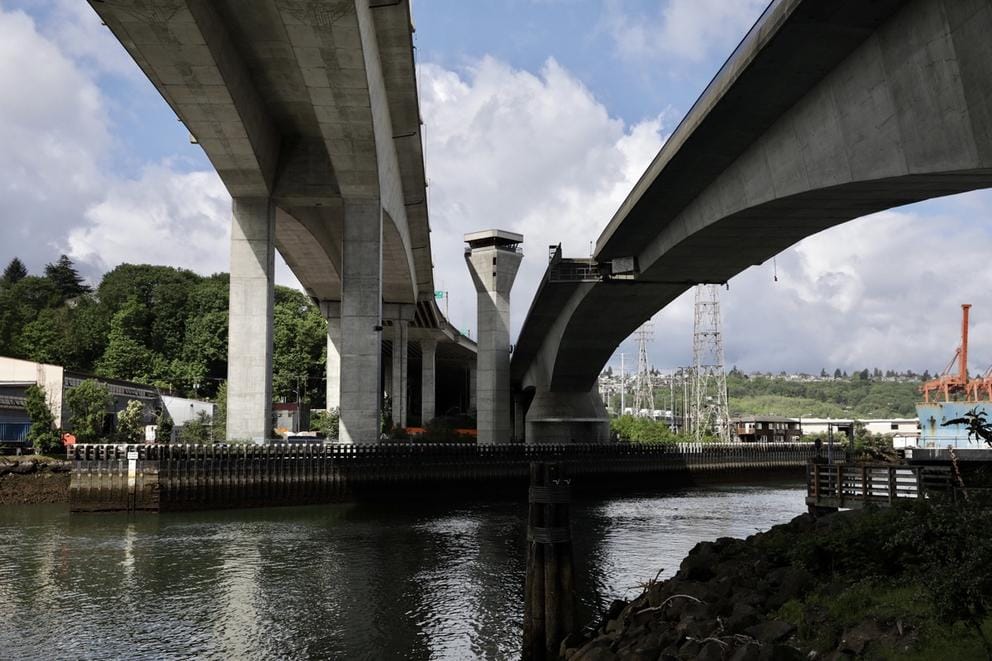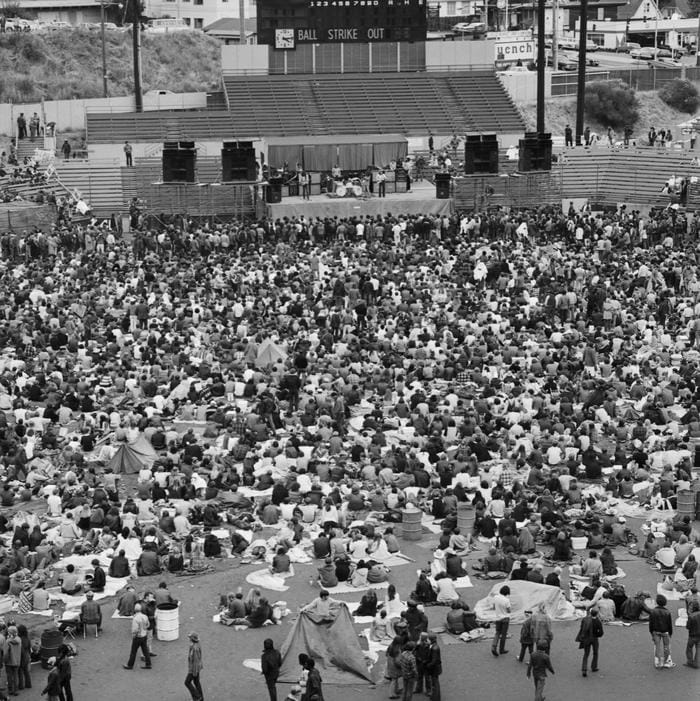Sept. 18, 2020, is the 50th anniversary of Jimi Hendrix’s death. I wrote about his life in my biography, Room Full of Mirrors, published in 2005. Posthumous battles for control of his estate and attempts to define his legacy persist, and have been novel-like in length and drama. The city’s role is complicated as well, with ongoing debates about what Seattle has done, and not done, and should do to honor the rock legend and native son.
So on this important anniversary, let me propose a bold idea (“bold as love,” after the 1967 album title), a way Seattle could honor Hendrix in a grand gesture:
Let’s name the West Seattle Bridge the “Jimi Hendrix Rainbow Bridge.”
With a nod to the 1972 documentary about Hendrix, Rainbow Bridge, the newly named West Seattle span would honor both Hendrix and Seattle’s commitment to rainbow inclusiveness. Undoubtedly, such an idea will face fierce criticism and obstacles. But I’m putting it forth nonetheless, because I think it’s time for dramatic action to honor people of color in this city, and Hendrix in particular.
The Hendrix statue on Broadway, unveiled in 1997, is likely the Seattle tribute that most people have seen. It is not an “official” city of Seattle memorial, though, and was instead created and paid for by local businessman Mike Malone (who started Muzak). In 2006, the Seattle Parks Department approved the creation of Jimi Hendrix Park, the two-acre green space abutting the Northwest African American Museum in the Central District.

While the city was working on the park’s design, the nearby lot on which Jimi’s childhood home sat came up for redevelopment. Efforts to get the city to save that house fell through, and reached a sad nadir in 2009 when it was taken down.
Other than the Hendrix park, there has been only one other official Seattle memorial: a heated rock that in the 1980s was installed in Woodland Park Zoo — in the African savannah exhibit — with Jimi’s name on it. Even this small gesture created controversy. On KIRO-TV, a commentator aired a rant saying it glorified a “drug addict.” It wasn’t even the city of Seattle that paid for the rock (radio station KZOK raised the funds), but it was approved by the Parks Department.
My idea may not be practical. In fact, I recently learned the West Seattle Bridge already has an honorific: the “Jeanette Williams Memorial Bridge,” so named in 2009 after a Seattle City Council member.
Williams was a progressive Democrat, and a musician, who I knew a little. I have never heard anyone call the West Seattle Bridge the “Jeanette Williams Bridge,” but that might be my ignorance. I suggested to some politician friends that if Williams were alive today (she died in 2008), she might see this idea as the right one for these times. I was told this would be politically impossible, in part because so few things in Seattle are named for women. Which is true.
But some kind of substantive gesture is long overdue. Almost every street in Seattle named for an individual is named after a white man. Many glorify presidents, early political figures or historic developers — in other words, those who initially took the land away from Native Americans. Next time you’re about, consider what that sign on the corner means and what it says about Seattle’s history.

The West Seattle Bridge seen alongside the Spokane Street Bridge over the Duwamish River in Seattle, May 6, 2020. (Matt M. McKnight/Crosscut)
When Seattle was founded in 1851, half of our first dozen streets were numbered, but the other half were named after Presidents, all slaveholders. (Andrew) Jackson Street was long the main arterial of the city’s Black and Asian communities. But Jackson’s biography makes him particularly ill fitted for naming rights, considering that his “Indian Removal Act” decimated the Native population (and was a model for Hitler and, some argue, for Trump).
The idea of changing Jackson Street to something more appropriate has come up before, but previous efforts have become bogged down in a debate about the expense for businesses to change signage and letterhead, among other concerns.
The same thing happened in the 1980s with the initial proposal that Empire Way be renamed Martin Luther King Jr. Way. Eddie Rye Jr., a friend of Hendrix’s, and one of his pallbearers, drove the effort. The name change faced citizen opposition and two years of lawsuits before eventually becoming law.
“We had to fight everybody,” Rye told me last week. “It had to go all the way to the state Supreme Court. I got threats and phone calls, and the Vietnam veterans had to protect my house.”
Even changing King County to honor Dr. King — instead of slaveholder William Rufus de Vane King, for whom it was initially named — barely passed the county council in 1986 (five votes for, four against). It took 10 more years for the state to approve the change in the image on the seal.
There have been some small shifts in naming Seattle streets. In 2014, part of 19th Avenue was named “Rev. Dr. S. McKinney Avenue” for the local civil rights and religious leader. In 2016, a three-block section of Jackson Street was renamed “Ernestine Anderson Way,” after the great jazz singer with Seattle roots. But these are “honorary” street names, not official changes, so essentially they mean that additional brown street signs appear under the official green street signs.
Though we now have the Jimi Hendrix Park, it follows a pattern that Tina Hendrix (Jimi’s niece) and others point out: parks, particularly microparks, are more likely than streets to be named for Black leaders. (She adds that the Jimi Hendrix Park doesn’t even have permanent bathrooms.)
The land used for Hendrix park might have better served the local Black community if it had been donated for affordable housing development, Tina says. King County Equity Now has raised this concern as well, and is also urging Seattle Public Schools to transfer ownership of the Central District’s Horace Mann Elementary School (which Hendrix attended; now Nova High School) to the Black community. Their argument is that the community needs concrete action — literally, as in dedicated buildings — to stop the neighborhood from being gentrified further.
“Jimi came from poverty and projects,” Tina Hendrix says. “At times … he was whitewashed to make people feel more comfortable with him. All of this has been so traumatic for my family.”
Hendrix isn’t even buried in Seattle: His father, Al, a gardener, couldn’t afford the cost of a Seattle plot, so Jimi is buried in Renton.
I came up with the West Seattle Bridge idea in early August, when engineering reports said the bridge had to be torn down and rebuilt. The thought hit me in the middle of a Zoom meeting with members of King County Equity Now. They had asked me to talk about Hendrix’s history in Seattle as part of their planning for the Peace & Love March for Equity (Sept. 18; details below), commemorating the 50th anniversary of his death. The group embraced the idea as one of its equity solutions, and it is now included as part of their call to action to address a “failure to properly honor Hendrix’s rich Black legacy.”

On that Zoom call, it was hard to even list how many racial barriers Hendrix faced in Seattle in the 1940s and 1950s. It is an embarrassing part of Seattle’s history, particularly for a city that likes to think of itself as progressive.
In 1942, when Hendrix was born at Harborview Hospital, redlining was legal, so like almost every Black person in Seattle, he lived in the Central District. Back then, overt and literal signs of racism abounded, such as a popular Lake City restaurant called “The Coon Chicken Inn” (which didn’t close until 1949).
“Black people couldn’t even try clothes on at downtown department stores,” recalls Hendrix’s friend Rye, who attended school with Hendrix. Theaters had separate “colored” entrances, sending Black people to the balcony. Even Seattle’s musician unions were segregated, with Denny Way demarcating the boundary — meaning that Hendrix, in the era of his youth, could never have played a concert at MoPOP, the museum that Paul Allen built in his honor.
Seattle police had such a reputation for racially motivated traffic stops in that era that the mayor in 1955 created a panel to investigate. It concluded that common police beliefs included, “Any Negro driving a Cadillac is either a pimp or a dope-peddler,” and that, “All Negroes carry knives.”
Jimi didn’t have a knife or a Cadillac, and yet in the first week of May 1961, the then 18-year-old was arrested twice in the span of four days for riding in a stolen car. There are no physical police records I could ever find, but Hendrix’s friends and family argue he was not a criminal, and that one of the cars was parked. His only crime was likely what is commonly called “driving while Black.”
Hendrix spent 10 days in jail for those two arrests. He was given the choice of joining the service or spending five years in prison. Jimi joined the Army, and left Seattle forever (except to return to play concerts).
Here’s the only way I can think to put this succinctly: Seattle forced out of town the man who would go on to become one of the most famous people ever born here — simply because he was Black.
It’s hard for me align this history with how many touring musicians I’ve seen come through Seattle over the years who name-check Jimi on stage and talk about how happy they are to be in his hometown. It’s hard for me to align all of this with my teenage fascination with Electric Ladyland. It is hard for me to align this with how important I think Hendrix was as a musician. One poor Black kid who grew up mostly in Seattle’s projects really can change culture and, in that way, change the world.
Naming the West Seattle Bridge for Hendrix might not be the perfect idea.
But the point is, I think it’s time for Seattle to give Hendrix his due. So does Rye, Jimi’s old friend. “I would like to see them do something more,” he says. “If only [to] change 23rd, from Cherry to Union, and name it for Hendrix. Something.”
To those who argue that it’s expensive to change the names of streets, Rye says he heard all that back in the ’80s with his proposal to name MLK Way. “There’s what costs, and there is what’s right,” he says. He also points out that the Daughters of the Confederacy managed to change the name of Highway 99 to the Jefferson Davis Highway in 1939. The highway held that designation until 2016, when the state Legislature finally changed it, and renamed Highway 99 for a Black veteran of the Civil War, William P. Stewart. Think about that the next time you drive down Aurora.
Other cities have done better with commemorating Black heritage. New Orleans has the Louis Armstrong Airport — not just an honorary brown sign, the actual name of the airport. Memphis has an Otis Redding Bridge. Hendrix isn’t Seattle’s only cultural groundbreaker that should be honored, and not all are people of color, but he’s a start.
It is worth noting that when Seattle Mariner Edgar Martinez retired in 2004, the city almost immediately changed the name of the street in front of the stadium to “Edgar Martinez Drive.” I love Edgar, but this was an official name, not an honorary brown sign, and it happened without years of debate, lawsuits or controversy. Mayor Greg Nickels said at the time, “Why wait?”
So why wait for Hendrix? Is a park enough, or not nearly enough? Could naming a bridge help bridge the gap between Seattle’s ideology and actions?
Let me leave you with an image that is often in my mind when I exit Interstate 5 south to get onto the West Seattle Bridge. The old Rainier Brewery sits at the approach, and for a time Hendrix lived in apartments there with his mother. It was a seedy, industrial area, but it was one of the only places outside the Central District where Black people were allowed to rent.
To me, I always feel a little bit of Jimi when I drive by, even 50 years after he’s been gone from this Earth. Whether the bridge is named after him — or there’s some other idea — he is part of Seattle.
He always will be.




